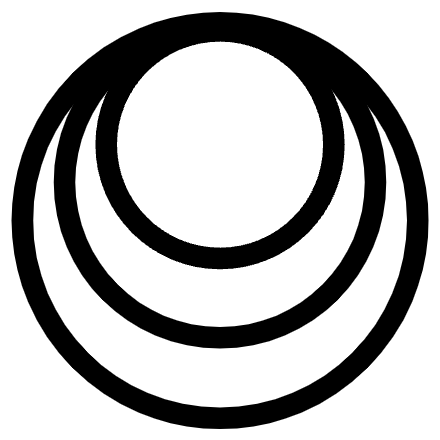In this incantation, I construct a comprehensive conceptual framework to map the totality of existence, allowing me to systematically chart and explore my reality. I begin by acknowledging my “demiscience,” or partial knowledge, and aim toward “omniscience,” the potential for complete understanding. I approach this by plotting existence based on belief, differentiating between my direct experiences and what I can only imagine. Through dimensions like the existential, temporal, spatial, and potential, I create a grid that encompasses all of these aspects. This evolving model reveals the path from limited to complete awareness, encompassing both the known and unknown, and inviting deeper insights into my place as the creator of reality.
In this incantation, I seek to construct a conceptual framework that can encompass the entirety of existence—like a container vast enough to hold every dimension of reality. This framework will allow me to systematically examine my experiences, identify patterns, and gain deeper insights into my place and understanding of myself. To achieve this, I must first explore and articulate all the dimensions of existence.
As I begin this process, I accept that my current knowledge represents only a small fraction of the whole—what I refer to as being “demiscient.” The prefix demi- signifies “partial,” while -scient refers to “knowing.” Thus, being demiscient means acknowledging the limits of my current understanding.
Upon exiting this model, I will have reached seen the articulated the path to becoming “omniscient.” The prefix omni- signifies “all,” and -scient again refers to “knowing.” To be omniscient, therefore, is to embrace the possibility of knowing everything.
The key variable between these two states is my conviction. My conviction that I my demiscience is itself a belief, and by simply understanding how it works I can regain my omniscience and understand my true identity. My goal is therefore to illuminate my journey from demiscience to omniscience, revealing how I can transition from a limited understanding of existence to a complete awareness of existence.
Part 1: Approach
In constructing this framework, my goal is to map every aspect of my reality—much like plotting points on a chart. The only criterion for something to be placed on this grid is my belief in its existence. If I believe it exists, it should be plottable on a space within the grid.
This belief-based qualification allows for a flexible model, where everything—from tangible objects to abstract concepts like memories and emotions or the experiences of other people—can be represented. By plotting each of these elements in an organized system, I can begin to recognize patterns and relationships that provide deeper insights into my reality. This grid becomes a living map, expanding and evolving as my beliefs shift and as new dimensions of existence are discovered.
Part 2: Existential
The first dimension of my model is existential, or being. By “existential,” I refer to any entity, human or otherwise, that exists and experiences. I can categorize all beings into two groups: myself and everyone and everything else. While “everyone else” could initially mean just other humans, it can also extend to all sentient beings capable of experiencing—whether animals, artificial intelligences, or even entities beyond current understanding. The specifics don’t matter; the essence is that these beings share the fundamental capacity for experiencing, and I am one of them. I can diagram it with two circles, as shown below.
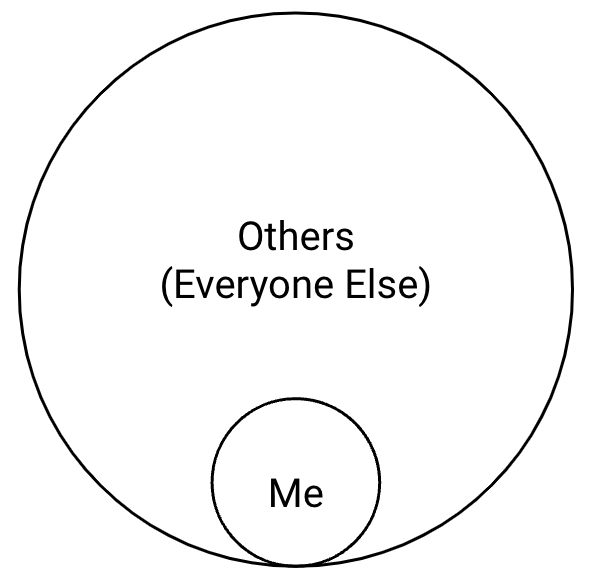
The Being dimension forms the foundational core of my model, with everything else branching outward. There are no beings outside of this two-part set.
Part 3: Potential
To expand on the dimension of being, I can distinguish between what I directly experience and what I can only imagine. For instance, I directly experience my own existence, but I can only imagine the experiences of others. This creates a distinction: my own experiences are vivid and immediate, while the experiences of others exist in my perception as imagined possibilities. They occupy a space with a “gray background,” representing the fact that I cannot truly experience them in the present moment—I can only speculate or envision them.
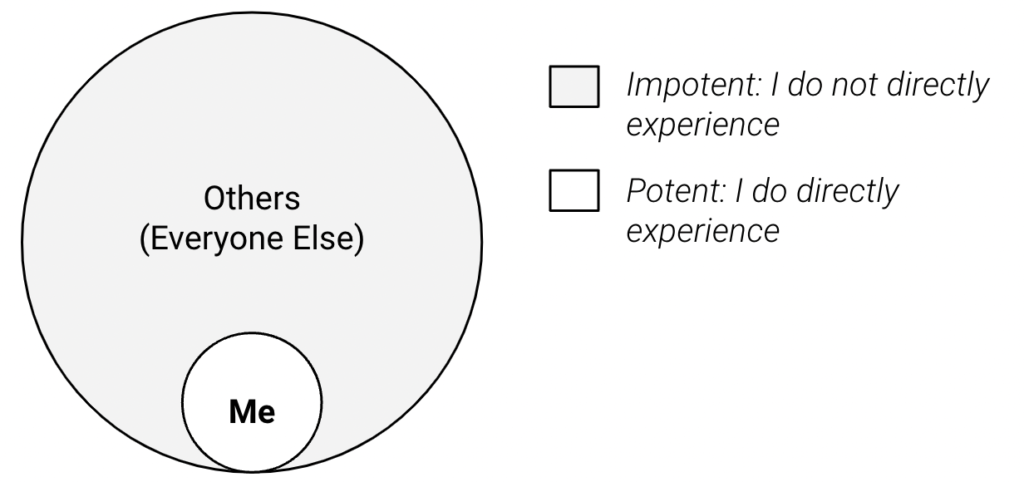
In my model, I refer to this dimension as “potential.” My direct and immediate experience is considered potent, while everything outside of my direct experience is regarded as impotent.
Part 4: Temporal
After existential, the next most important dimension is the temporal, representing time. Time can be best modeled as a grid, rather than circles. I imagine a simple grid, organized either vertically or horizontally—it doesn’t matter which, as both represent the same concept: the entirety of time. Nothing exists outside of this system in terms of time.

Do I believe that the past, present, and future exist? If so, this grid represents a part of that reality. I can expand on the grid by distinguishing between what I actually experience and what I can only imagine. For example, I cannot directly interact with the past or future; I can only imagine them, as they are beyond my immediate experience. The gray background symbolizes those aspects of time which I cannot directly experienced in the present moment.

Part 5: Existential, Temporal, Potential
Now I have two grids: one for being and one for time. I’ve also marked the distinction between what I can directly experience and what I cannot, using a gray background for the latter. The next step is to combine these two grids into a single framework, showing being, time, and the contrast between what I experience firsthand and what I can only imagine (potency).

I can further improve this grid by removing redundant information out of the grid. In this grid below, I have captured the complete set of all beings across all times, highlighting both what I directly experience and what I can only imagine.

Part 6: Spatial
In this single grid, I represent the totality of existence in terms of the existential, temporary, and potential. Now, let’s divide my experience into two distinct parts: what I perceive spatially in front of me, and what I conceive inwardly—mentally, emotionally, and sensationally. These two dimensions occupy separate and distinct areas or spaces within my awakening experience: an inner space of conception, and an outer space of perception. I refer to these as the spatial dimensions and they refer to where my experience is occuring. I can visualize this in a simple form, divided into that which I conceive and that which I perceive:
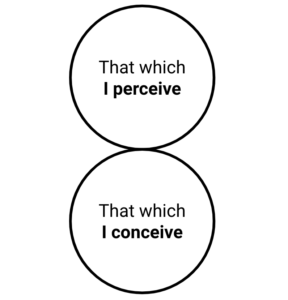
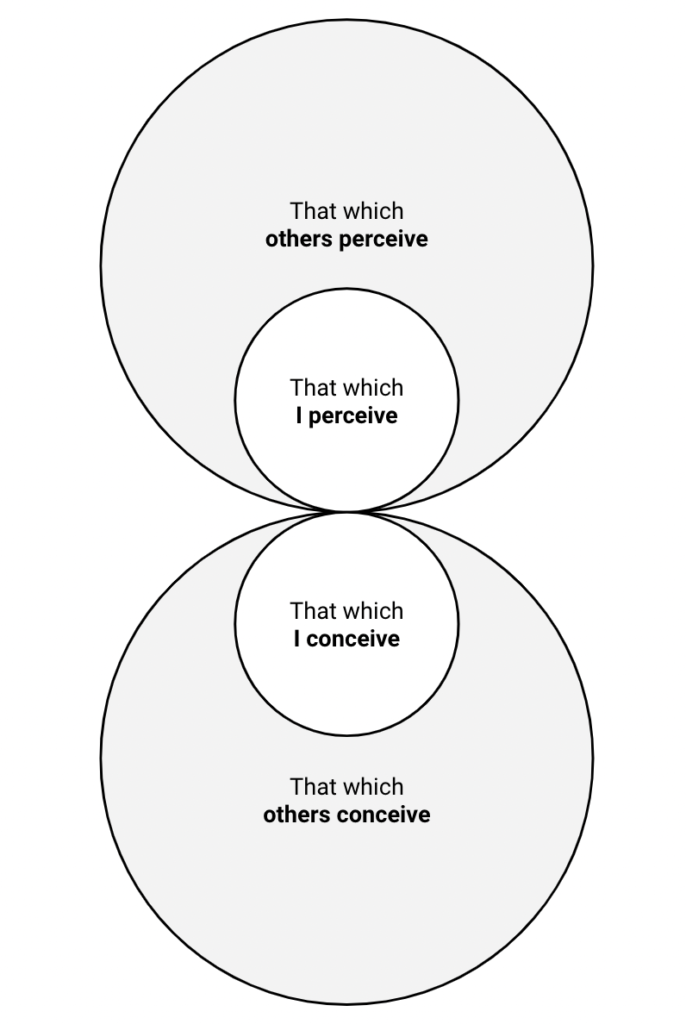
I can simplify this by converting it into a straightforward graph. This graph will depict the totality of all beings—myself and others—along with their respective conceptual and perceptual experiences, clearly distinguishing between my own experiences and those of others. Like I did with time, I can pull out the common factors to the left side. I add a thick line between the perceptual and conceptual to indicate the break between inner and outer spaces.

Now I can simplify and merge all of these dimensions—existential, temporal, potential, and spatial—into a single comprehensive grid.


With this grid, I have now reached a point where I can map the experience of every being, across all times, in a precise and organized way.
Part 7: Known and Unknown
Now I can think of the totality of all existence in these terms, comprising the past, present, and future, all beings and their respective perceptual versus conceptual experiences, and whether I can directly or only indirectly experience those things. Now, can I express the totality of existence in this one grid? Is absolutely everything that exists now, has ever existed, and will ever exist included in this grid and diagram? I include that which I both conceive and perceive, which is a subset of that which all beings conceive and perceive. I see that I am missing one important segment of existence: that which exists, but no one directly experienced.

The “unknown knowable” is both conceptual and perceptual. For me, right now, in my bedroom, I believe that there are other parts of my house right now even though I am not experiencing them directly. That would be the unknown knowable because it is unknown or not experienced, but I believe I can experience it.
I can also update my circular diagram, if that helps. I can compress them into oval shapes to save space.
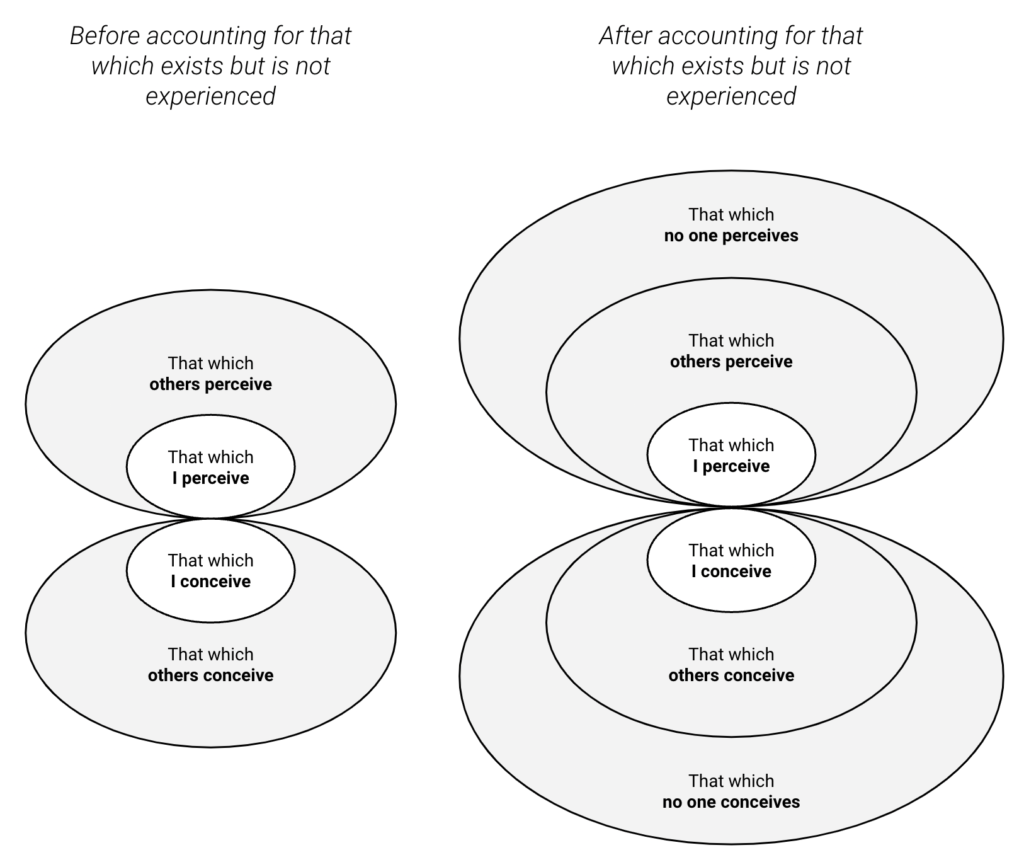
Part 8: Knowable and Unknowable
And now I have also included all that which exists, yet neither me, nor any others have, are, or will conceive and perceive. Is that everything? This depends on whether I believe whether there are things that are completely unknowable or not. For example, if I responded to a question about life with “only God knows”, then I probably believe there is a segment of reality that is simply unknowable to me as a human. To add this section to my grid, I must subdivide the Unknown into both a knowable and unknowable segment, as shown below.

And in our circular format, compressed for space:

Part 9: Relativity to Me
The final piece of the grid resolves down to the fact that every cell on this grid, from my perspective, is conceptual. Even those perceptual experiences that I do not directly experience, are themselves conceptual to me. I can distinguish these by changing the color of all cells which are conceptual to me to green, and that which is perceptual to blue.
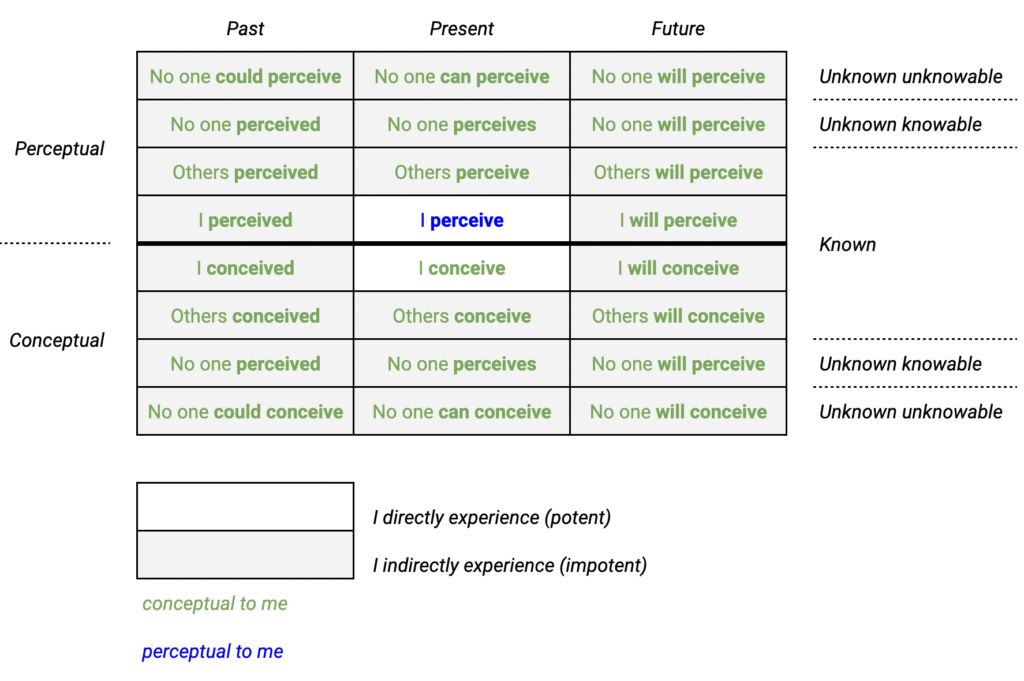
I must remind myself that the sole qualification for being part of this grid is my belief in its existence. If I accept it as real, then I should be able to map it onto this model. I must also recognize that the model’s purpose is to help me escape the maze I’ve constructed around myself. My objective is to peel back the layers and find a way out. This can only happen if I embrace my true nature and identity. By using this model, I can uncover the contradictions and illusions within my awakening beliefs, allowing me to fully embrace my omniscience.
…
Questions
- What belongs in the grid? The grid is intended to include the totality of existence. Everything that I believe exists should fit into this grid.
- Why am I at the center? I am at the center because this model is intended to demonstrate what I know versus I do not know. The most potent component of my existence and being is that I am. Therefore I am at the very center, and I can chart everything else outside of that.
- What distinguishes white from gray? Can I know, experience, and validate it right now? If no, then it’s gray because it is literally imaginary.
- How does this grid relate to anything else? The more I believe is real and existent, the more I will value and desire possession of things that I believe I do not have.
- How do I move things into specific cells on the grid? I must simply determine who or what knows it, when, and in what capacity (perceptual vs conceptual).
- Why am I writing this now? Perhaps it is time to start bringing the people of secondself and thirdself along, so I speak to them.
